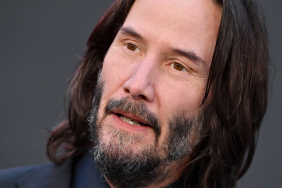On the Lionsgate-released zom-com

Most people think the origins of the zombie movie go back to the ’60s or ’70s, but in director Andrew Currie’s zombie comedy Fido, he traces them back to the idyllic ’50s suburb of Willard where zombies have been trained to be personal servants. When young Timmy Robinson befriends their zombie butler, naming him “Fido”, he quickly discovers what happens when good pets go bad. Influenced by “Lassie,” “Leave it to Beaver” and the movies of Douglas Sirk, Currie’s zom-com stars a clean-shaven Billy Connolly as Fido and Carrie Anne Moss as Timmy’s mother, who has other uses for the rugged zombie servant. As ShockTillYouDrop.com found out when we talked to Currie back in January as the movie debuted at the Sundance Film Festival, it’s a project that has taken 13 years to finally get to theatres.
ShockTillYouDrop.com: I first heard about this movie at San Diego Comic-Con in 2005 at the Lionsgate panel, which was over a year ago, so how come it’s taken so long to get it released?
Andrew Currie: Oh, we were shooting it then, that makes sense. We actually didn’t finish the movie until June of 2006. What happened was I was shooting and I finished it in February 2006, and I did a cast and crew screening, and I wasn’t happy with it. I felt I rushed too much, so I went back in and took 9 minutes out of the movie, and I did some more music work. By the time that was finished, it was literally June 2006, then we went straight into the Toronto Film Festival, and we held back because Sundance saw the film and really loved it. Lionsgate decided that Sundance was a really good film festival to wait for, so we waited for that.
Shock: How have the audiences here been different than those in Toronto?
Currie: I don’t know, because I haven’t been to one. I mean, tonight’s my night.
Shock: Would you actually watch your movie again with a crowd?
Currie: I’m going to try. It’s almost hard to watch your own movies. It just doesn’t seem funny any more for me.
Shock: But you could see how the audience reacts to the jokes.
Currie: Yeah, it will be nice, and to see it with an American audience will be really exciting.
Shock: I’m sure it won’t be that different from how Canadian audiences react. You’re from Canada yourself, right?
Currie: I was born in England, but grew up in Canada, in Victoria.
Shock: I was surprised that you didn’t write this movie.
Currie: There’s three writers: myself, Robert Chomiak and Dennis Heaton. At a certain point, about a year before production, it was just me and one of my producers Blake [Corbet] in the story room, just stepping it up a little more.
Shock: But you’ve been involved with this project from the very beginning?
Currie: Yes, pretty much. In 1994, Dennis Heaton had this story about a kid who had a pet zombie he fed raw meat to that would stop the zombie from eating people. We really loved that premise and decided to write a script based on that, so Dennis, Robert and I wrote the first draft in ’94, a long time ago, and it sort of just went through development hell and was shelved for a long time, and then a few years ago, we went back to it and really deepened the characters and worked from a theme. The whole thing suddenly came into a focus.
Shock: So this actually started before the current zombie craze? It’s not really as much a zombie movie as it is a dark comedy though, so were you a fan of the zombie genre?
Currie: You know, I’m a fan of⦠I like horror films and zombie movies. For me, zombies are just great metaphors. You can sort of place different social issues on their shoulders quite nicely, and that was what I was doing in “Fido.”

Shock: Was it always the idea to set this story of a boy and his zombie in the ’50s?
Currie: No, for me, I wanted to set it in the ’50s for a couple of reasons: I was really influenced by Douglas Sirk films, and I loved the old Technicolor films, and I wanted it to be set in a time that in our minds was an idyllic time, that we imagine it to be idyllic. That was sort of the post World War II boom era, and I wanted it to have a sort of fable-like quality. I didn’t want to set it in the modern world, but really, what the film is doing is commenting more on the modern world than on the ’50s. What Mr. Bottoms says at the beginning when he’s talking to the class and he’s saying how they’re building the fence bigger, which you know, right now, Bush has been talking about that wall between Mexico and the U.S., which is kind of scary, but they’re building the fences higher. They’re going to have security vans on every street, and then he says to the kids, “And we’re going to take every one of your pictures. Just in case one of you gets lost.” So there is that modern commentary that is running through it.
Shock: Was the movie influenced at all by the B-horror movies of the ’50s like “Them!” or “Invasion of the Body Snatchers”?
Currie: Well, yeah, I mean that’s the thing. Because it’s a genre film, I was playing with some of the movies I loved like the melodramas of Douglas Sirk with that Technicolor look, but also the horror genre, the boy and his dog “Lassie” movies, so it sounds almost easy I guess, but it’s really hard taking disparate genres and blending them in a graceful way. It was very challenging and very rewarding for me. I did a lot of work ahead of time. I storyboarded the entire film. I did conceptual art. I was working with my composer for a year ahead of time, and so I really tried to define the world even before we shot as much as possible, so that when we came to making the movie, it would go quickly. We could pull off what we had to pull off in such a short time.
Shock: Can you talk about the casting? First of all, about getting Billy Connolly to shave his trademark beard, how did you convince him to do that?
Currie: He was bitter. (laughs) Nott really. He’s such a great guy. I remember I walked in to see how he was doing. They had cut all his hair and shaved his beard and he looked at me and goes, “You’re tearing off my frickin’ personality here.”
Shock: If I didn’t have notes, I wouldn’t have had any idea it was him, because he doesn’t talk and we never heard his Scottish accent.
Currie: Although it’s funny because certain moans he does, you can hear the Scottish in them.
Shock: And what about Carrie Anne Moss? How did you know she would be the perfect ’50s Mom?
Currie: She read the script and really loved it, and when I went down and met her, we just talked and she got the character so well, and got the levels of the film and she really embraced it for what it was. My instinct said that she would be perfect for it, and she really was. Her performance is wonderful. It’s something we’ve never seen before with her.
Shock: The kid’s also really good. Was this his first movie?
Currie: I think he did one cable movie, but yeah, he’s a newbie. We looked at over 600 kids before him.
Shock: How did you explain to him the ’50s references, since he wasn’t likely to have seen any of the movies you were referencing? How did you explain to him the kind of archetype he was playing?
Currie: I wanted to stay away from the cliches of “Golly gee willikers” too much, but the language, the way the dialogue is written, is a big part of it and the costuming and the environment is the biggest part of it.
Shock: I was kind of impressed with the Zomcom building. Was that a model that looked really good or did you actually dress up a factory to look like that?
Currie: It was actually a Hiram Walker plant, and Hiram Walker is basically, they make rye I think, and it was closed down. When the cars comes in and you see the wide shot, there is a digital front that’s been put on it, so there was a special visual effect that made that.

Shock: Since the movie involves zombies, how did you decide how much gore you wanted to include in the movie? Horror fans will have expectations of a certain amount or type of gore, so how did you incorporate that into the ’50s setting?
Currie: To me, the audience for “Fido” has always been sort of in my mind⦠because of the social satire and some of the subtler family dynamic stuff, I always thought people in their mid-20s and up would get it the best. Certainly, 18 years old and up would hopefully enjoy it too. When we did do screenings, we found that it seemed most popular for men and women in their 20s and their 30s, but we had people up in their 70s digging the film. What was important to me was to reach an audience that enjoyed intelligent satire, and I felt like if I went too far into the gore, that it would push out a lot of people that I think would appreciate the movie, so what I did was I approached a lot of the violence in a very specific way. For example, when Timmy has to kill the neighbor with the shovel, I did it as a silhouette, and I think that’s just a sort of classier way of showing a kid kill.
Shock: It also fits more into the ’50s aspect of the movie.
Currie: Exactly and all the visual effects were done in that way. Like the moon was hand-painted on glass. We had an artist paint it that way and scan it. I did all the driving shots like they were rear projections. We used digital technology to help, but I still wanted those effects to look like they were made in the 1950s.
Shock: How has it been working with Lionsgate on this? This is very different from the horror movies they tend to make and from the movies they release in general.
Currie: They’ve been just fantastic. Lionsgate, when they came on board, they said, “You never get delivered what you think you’re going to get,” and with “Fido” they did and they were so happy. I think because I did so much conceptual art and storyboards, I showed them what it was going to look like and then it’s a matter of following through with it.
Shock: What are you doing next? You’ve obviously been done with this movie for almost a year now.
Currie: Yeah, I’m writing my next script. It’s called “The Truth About Lying,” and it’s sort of a comedy drama, and it’s really about a guy in his 20s who’s a compulsive liar who finds out that his mother is actually a pathological liar and that the man he thought was his father isn’t at all. She went to a sperm bank and got an anonymous donor.
Shock: So you don’t foresee yourself staying in the horror genre after making this movie?
Currie: No, no. I mean really for me is that I love character and character-driven. I love humor and drama both and I think as long as it comes out of the characters, it’s always the best.
Fido opens in New York City on June 15 and in other cities after that.



Source: Edward Douglas









